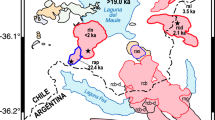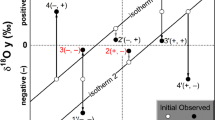Abstract
Distribution coefficients D of Au and Pd between magnetite (manganmagnetite) and ammonium chloride hydrothermal solution and the structural D str and surface-related D sur terms of these coefficients were determined at 450 and 500°С and a pressure of 1 kbar using internal sampling techniques. Quantitative data on the speciation of precious metals are obtained using the technique of statistical selections of analytical data on single crystals SSADSC and compared with LA-ICP-MS data. Both Pd and Au are elements compatible with magnetite and its manganoan variety: D str is ≈3 for Pd and ≈1 for Au, although Au seems to weakly enrich fluid at 500°C: D str ≈ 0.5–0.8. The trends of postmagmatic Pd and Au fractionation can thus strongly depend on the presence of spinel-group minerals, first of all, magnetite and its solid solutions. The dualistic nature of the distribution coefficients provides sound grounds to believe that both elements are highly compatible, with regard not only for the structural but also for the surface-related modes of their occurrence (D sur ≈ 17 and ≈50–70 for Au and Pd, respectively). The maximum concentrations of structural modes of the elements are 5.3 ppm for Au and 5.1 ppm for Pd and were found in the solid solution whose jacobsite mole fractions were 0.82 and 0.49, respectively. The principal distribution patterns of the elements in crystals are confirmed by LA-ICP-MS data. Data on this system testify that the distribution coefficients of minor and trace elements are geochemically dualistic because of the abnormal absorption properties of nanometer-sized nonautonomous phases on the surface of ore minerals, and this dualism plays an important geochemical role.
Similar content being viewed by others
References
V. V. Akimov and V. L. Tauson, “Accumulation of trace elements in mosaic and micrograined mineral crystals: experimental data,” Geochem. Int. 41 (11), 1201–1210 (2003).
B. L. Belykh, N. I. Skripov, V. V. Akimov, V. L. Tauson, T. P. Stepanova, and F. K. Shmidt, “The state of palladium in the nano-sized hydrogenation catalysts modified with elemental phosphorus,” Russ. J. General Chem. 83 (12), 2260–2271 (2013).
A. E. Boudreau and W. P. Meurer, “Chromatographic separation of the platinum-group elements, gold, base metals and sulfur during degassing of a compacting and solidifying igneous crystal pile,” Contrib. Mineral. Petrol. 134(2–3), 174–185 (1999).
J. M. Brenan, C. F. Finnigan, W. F. McDonough, and V. Homolova, “Experimental constraints on the partitioning of Ru, Ir, Pt and Pd between chromite and silicate melt: the importance of ferric iron,” Chem. Geol. 302–303, 16–32 (2012).
J. M. Brenan, W. F. McDonough, and C. Dalpe, “Experimental constraints on the partitioning of rhenium and some platinum-group elements between olivine and silicate melt,” Earth. Planet. Sci. Lett. 212 (1–2), 135–150 (2003).
C. J. Capobianco, R. L. Hervig, and M. J. Drake, “Experiments on crystal/liquid partitioning of Ru, Rh and Pd for magnetite and hematite solid solutions crystallized from silicate melt,” Chem. Geol. 113 (1–2), 23–43 (1994).
L. L. Chyi and J. H. Crocket, “Partition of platinum, palladium, iridium, and gold among coexisting minerals from the deep ore zone, Strathcona Mine, Sudbury, Ontario,” Econ. Geol. 71 (7), 1196–1205 (1976).
J. E. Collins, S. J. Barnes, S. G. Hagemann, T. C. McCuaig, and K. M. Frost “Postmagmatic variability in ore composition and mineralogy in the T4 and T5 ore shoots at the high-grade Flying Fox Ni–Cu–PGE deposit, Yilgarn Craton, Western Australia,” Econ. Geol. 107 (5), 859–879 (2012).
J. H. Crocket, Y. Teruta, and J. Garth, “The relative importance of sulfides, spinels, and platinoid minerals as carriers of Pt, Pd, Ir, and Au in the Merensky Reef at Western Platinum Limited, near Marikana, South Africa,” Econ. Geol. 71 (7), 1308–1323 (1976).
S. A. S. Dare, S.-J. Barnes, and G. Beaudoin, “Evolution of trace element concentrations in magnetite from a fractionating magmatic sulfide liquid: an example from the Sudbury (Canada) Ni–Cu–PGE deposits,” in 11th SGA Biennial Meeting. (Univ. Catal. Norte, Antofagasta, 2011), pp. 621–623.
M. Economou-Eliopoulos and D. G. Eliopoulos, “Mineralogical and geochemical characteristics of the Skouries porphyry–Cu–Au–Pd–Pt deposit (Greece): evidence for the precious metal,” in Mineral Deposit Research: Meeting the Global Challenge, Ed. by J. Mao and F. P. Bierlein (Springer, Berlin–Heidelberg, 2005), pp. 935–938.
M. E. Fleet, J. H. Crocket, M. Liu, and W. E. Stone “Laboratory partitioning of platinum-group elements (PGE) and gold with application to magmatic sulfide-PGE deposits,” Lithos 47 (1–2), 127–142 (1999).
Yu. A. Kovalenko, A. M. Nugmanov, and L. Yu. Firsova, “The influence of synthesis conditions on magnetite structure imperfection,” Russ. J. Phys. Chem. A 75 (11), 1983–1087 (2001).
R. G. Kravtsova, Geochemistry and Conditions of the Formation of Gold–Silver Ore-Forming Systems of the Northern Okhotsk Region (Geo, Novosibirsk, 2010) [in Russian].
R. R. Large, L. Danyushevsky, C. Hollit, V. Maslennikov, S. Meffre, S. Gilbert, S. Bull, R. Scott, P. Emsbo, H. Thomas, B. Singh, and J. Foster, “Gold and trace element zonation in pyrite using a laser imaging technique: Implications for the timing of gold in orogenic and Carlin-style sediment-hosted deposits,” Econ. Geol. 104 (5), 635–668 (2009).
C. Li and E. M. Ripley, “The roles of fluid in the genesis and modification of reef-type PGE deposits in large layered intrusions,” Geochim. Cosmochim. Acta 69 (10), A332 (2005).
V. I. Men’shikov, I. Yu. Voronova, O. A. Proidakova, S. F.Malysheva, N. I. Belogorlova, N. K. Gusarova, and B. A. Trofimov, “Preconcentration of gold, silver, palladium, platinum, and ruthenium with organophosphorus extractants,” Russ. J. Appl. Chem. 82 (2), 183–189 (2009).
A. J. Naldrett, J. Singh, S. Krstic, and C. Li, “The mineralogy of the Voisey’s Bay Ni–Cu–Co deposit, Northern Labrador, Canada: influence of oxidation state on textures and mineral compositions,” Econ. Geol. 95 (4), 889–900 (2000).
R. Piña, F. Gervilla, S.-J. Barnes, L. Ortega, and R. Lunar, “Platinum-group elements-bearing pyrite from the Aguablanca Ni-Cu sulphide deposit (SW Spain): a LA–ICP–MS study,” Eur. J. Mineral. 25 (2), 241–252 (2013).
T. D. Radhakrishnan Nair, and C. U. Aniz, “Effect of redox nature of impregnated ferrite catalysts on their carbon monoxide oxidation activity,” Res. Rev.: J. Mater. Sci. 1 (2), 45–52 (2013).
K. Righter and R. T. Downs, “The crystal structures of synthetic Re- and PGE-bearing magnesioferrite spinels: Implications for impacts, accretion and the mantle,” Geophys. Res. Lett. 28 (4), 619–622 (2001).
N. V. Smagunov and V. L. Tauson, “Magnetite and pyrrhotite as potential gold concentrators at low sulfur activity,” Dokl. Earth Sci. 392 (7), 995–998 (2003).
V. L. Tauson and V. V. Akimov, “Introduction to the theory of forced equilibria: General principles, basic concepts, and definitions,” Geochim. Cosmochim. Acta 61 (23), 4935–4943 (1997).
V. K. Taroev and V. L. Tauson, Analysis of “Unit Cell Parameters–Composition” Correlations in Spinel Systems with Magnetite (IGKh SO RAN, Irkutsk, 1984) [in Russian].
V. L. Tauson, “Endocrypty: modern concepts and investigation techniques,” Geochem. Int. 37 (6), 588–591 (1999).
V. L. Tauson, “Systematics of processes of trace element uptake by real mineral crystals,” Geochem. Int. 43 (2), 184–190 (2005).
V. L. Tauson, “The Principle of Continuity of Phase Formation at Mineral Surfaces,” Dokl. Earth Sci. 425A (3), 471–475 (2009).
V. L. Tauson and S. V. Lipko, “Pyrite as a concentrator of gold in laboratory and natural systems: a surface-related effect,” in Pyrite: Synthesis, Characterization and Uses. Chapter 1 Ed. by N. Whitley and P. T. Vinsen (Nova Sci. Pub. Inc., New York, 2013), pp. 1–40.
V. L. Tauson and E. E. Lustenberg, “Quantitative determination of modes of gold occurrence in minerals by the statistical analysis of analytical data samplings,” Geochem. Int. 46 (4), 423–427 (2008).
V. L. Tauson, I. Yu. Parkhomenko, D. N. Babkin, V. I. Men’shikov, and E. E. Lustenberg, “Cadmium and mercury uptake by galena crystals under hydrothermal growth: a spectroscopic and element thermorelease atomic absorption study,” Eur. J. Mineral. 17 (4), 599–610 (2005).
V. L. Tauson, T. M. Pastushkova, D. N. Babkin, T. S. Krasnoshchekova, and E. E. Lustenberg, “Effect of particle size variation in a sample on trace element concentration,” Dokl. Earth Sci. 429 (6), 1590–1596 (2009).
V. L. Tauson, T. M. Pastushkova, D. N. Babkin, T. S. Krasnoshchekova, and E. E. Lustenberg, “The effect of the crystal size in sample on the trace-element concentration,” Russ. Geol. Geophys. 51 (7), 764–773 (2010).
V. L. Tauson, D. N. Babkin, T. M. Pastushkova, T. S. Krasnoshchekova, E. E. Lustenberg, and O. Yu. Belozerova, “Dualistic distribution coefficients of elements in the system mineral–hydrothermal solution. I. Gold accumulation in pyrite,” Geochem. Int. 49 (6), 568–577 (2011).
V. L. Tauson, D. N. Babkin, T. M. Pastushkova, V. V. Akimov, T. S. Krasnoshchekova, S. V. Lipko, and O. Yu. Belozerova, “Dualistic distribution coefficients of elements in the system mineral–hydrothermal solution. II. Gold in magnetite,” Geochem. Int. 50 (3), 227–245 (2012).
V. L. Tauson, D. N. Babkin, V. V. Akimov, S. V. Lipko, N. V. Smagunov, and I. Yu. Parkhomenko, “Trace elements as indicators of the physicochemical conditions of mineral formation in hydrothermal sulfide systems,” Russ. Geol. Geophys. 54 (5), 687–706 (2013).
V. L. Tauson, R. G. Kravtsova, N. V. Smagunov, A. M. Spiridonov, V. I. Grebenshchikova, and A. E. Budyak, “Structurally and superficially bound gold in pyrite from deposits of different genetic types,” Russ. Geol. Geophys. 55 (2), 350–369 (2014).
V. L. Tauson, S. V. Lipko, K. Yu. Arsentev, and N. V. Smagunov, “Formation of multiphase mineral associations and selection of components by growing crystals: interdependent problems of crystal genesis studied by A.E.Glikin and related to superficial nanostructures,” in Abstr. III Internat. Conf. “Crystallogenesis and Mineralogy” (Publishing House of SB RAS, Novosibirsk, 2013), pp. 204–205.
V. S. Urusov, V. L. Tauson, and V. V. Akimov, Geochemistry of Solids (GEOS, Moscow, 1997) [in Russian].
N. Vatin-Perignon, J. Amosse, L. Radelli, F. Keller, and T. Castro Leyva, “Platinum group element behavior and thermochemical constraints in the ultrabasic–basic complex of the Vizcaino Peninsula, Baja California Sur, Mexico,” Lithos 53 (1), 59–80 (2000).
Y. Xiong and S. A. Wood, “Experimental quantification of hydrothermal solubility of platinum-group elements with special reference to porphyry copper environments,” Mineral. Petrol. 68 (1–3), 1–28 (2000).
Z. Zajacz, J. J. Hanley, C. A. Heinrich, W. E. Halter, and M. Guillong, “Diffusive reequilibration of quartzhosted silicate melt and fluid inclusions: Are all metal concentrations unmodified?,” Geochim. Cosmochim. Acta 73 (10), 3013–3027 (2009).
Author information
Authors and Affiliations
Corresponding author
Additional information
Original Russian Text © V.L. Tauson, D.N. Babkin, T.M. Pastushkova, N.V. Smagunov, S.V. Lipko, I.Yu. Voronova, V.I. Men’shikov, N.V. Bryanskii, K.Yu. Arsent’ev, 2016, published in Geokhimiya, 2016, No. 2, pp. 165–181.
Rights and permissions
About this article
Cite this article
Tauson, V.L., Babkin, D.N., Pastushkova, T.M. et al. Dualistic distribution coefficients of trace elements in the system mineral–hydrothermal solution. III. precious metals (Au and Pd) in magnetite and manganmagnetite. Geochem. Int. 54, 149–166 (2016). https://doi.org/10.1134/S0016702916020063
Received:
Accepted:
Published:
Issue Date:
DOI: https://doi.org/10.1134/S0016702916020063




